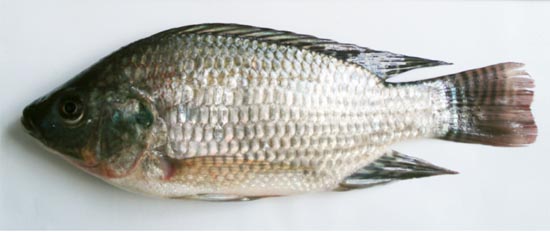
Synonyms:
Chromis (Tilapia) mossambicus: Peters, 1852.
Tilapia mossambica: Jones and Sarojini, 1952.
Oreochromis mossambica: Trewavas, 1983.
Common name: Mozambique Tilapia (English name).
Local name: Tilapia.
Taxonomic position:
Phylum: Chordata
Class: Osteihthyes
Order: Perciformes
Family: Cichlidae
Genus: Oreochromis
Species: O. Mossambicus
Morphological description:
Elongated body is fairly compressed and deep. Upper profile is more convex than ventral. Mouth is terminal and very wide. Lateral line is complete. The snout is rounded and jaws are equal. Dorsal fin is inserted above the base of the pectoral fin. Caudal fin is rounded. Scales are cycloid. Body colour of females and non-breeding males is watery grey to yellowish, body of males in breeding season deep black. Dorsal fin is black with a red margin, pectoral fins translucent red, caudal fin with a broad red margin. This morphological description is similar to Talwar and Jhingran (2001), Yadav (1997). It is an exotic species of Bangladesh which is imported as a cultured species at 1954 from Thailand.
Fin formula:
D. XV-XVI/10-12, P1. 14-15, P2. I/5, A. III/10-12.
D. XV-XVI 10-12, P1. 14-15, P2. I 5 A. III 10-11 (Talwar and Jhingran, 2001).
Scales number on the lateral line series is 30 to 31. Scales number above the lateral line is 11 to 13 and below the lateral line is 10 to 11 where as Talwar and Jhingran (2001) mentioned the scales number on the lateral line series of this fish is 30-32.
Habits and habitat:
Surface dweller and omnivorous fish, Inhabits both brakish water and fresh water (Yadav, 1997).
Breeding time:
This fish starts breeding at the age of only two months and it breeds 4 to 6 times in a year (Yadav, 1997).
Economic importance:
Tilapia is a hardy fish. It is becoming increasing important as food fish in the whole world. These fish are suitable for farming because they can be breed easily and high yielding. Beside ecological role tilapia is harmful for aquaculture along with Indian major carps because of the adverse effect it causes on the growth and production of carps, and it on carp fry (Talwar and Jhingran, 2001).
Ecological role:
These fish is omnivorous. So it takes all kinds of foods and makes the water of culture pond fresh and clean. In this way tilapia plays and important role in our ecology (Yadav, 1997).
Marketing status:
Market price varied between 85- 110 Tk/Kg.
Reference:
Jones, S. and Sujansinghani, K.H. 1952. Fish and Fisheries of the chilka lake with statistics of the fish catches for the years 1948-50. Indian J. Fish. 1: pp. 256-344.
Peters, W. (C.H.), 1852. (in German) Uber die Von Hrn. Dr. F. Jagorin dem ostindischen Archipel gesammelten and dem Konigl. Zoologischen Museum Uberge benen Fishche. Monat sb. Akad. Wiss. Berlin, pp. 254-281.
Talwar, P.K. and Jhingran, A.G. 2001. Inland Fishes of India and Adjacent countries. Oxford and IBH Publishing Co. Pvt. Ltd. New Delhi. 2: pp. 887-888.
Trewavas, 1983. Tilapine Fishes: p. 292.
Yadav, B.N. 1997. Fish and Fisheries. Daya Publishing House, Calcutta. p. 326.
Visited 9,697 times, 2 visits today | Have any fisheries relevant question?
